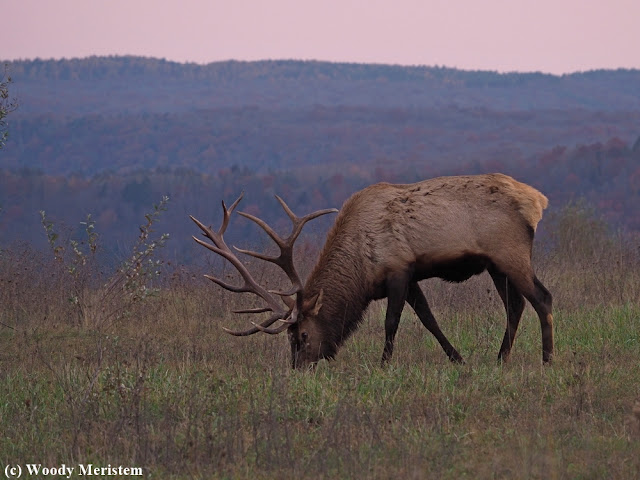The last several visits to
Pennsylvania’s elk range were relatively unsatisfying since there
were few elk to be seen. One of the places we had visited was Winslow
Hill where, years ago, there were always a lot of elk.
Winslow
Hill is also the area where the multi-million dollar visitor center
complex was built a few years ago. The complex has two buildings,
several large parking lots, a restored farmhouse that can be rented
and wagon rides. During the elk rut the large parking lots are often
full and there are vehicles parked on the grass. Meanwhile large tour
busses climb the road to the visitor center, diesel engines roaring.
“The Elk
Country Visitor Center
... sees an (sic) upward of 480,000 visitors
every year.”
(Keystone Elk Country Alliance)
Is
it any wonder that there are fewer elk to be seen on Winslow Hill????
Since
I’d rather see elk than either people or large tour busses, like some
other elk photographers I've given up on Winslow Hill and would
rather seek the animals in other locations where elk live a more
normal and undisturbed life. And so H and I planned to travel to a “secret
undisclosed location” in search of elk.
On
the road at 5:30am, picking up breakfast and coffee on the way, we
arrived at the chosen location, after driving over deep ruts and even
deeper potholes,
just as the light became sufficient for photography. There, far from
the maddening crowds, we found a couple of bands of elk. One small
bull and
about ten cows and calves and shortly after a very large bull with a
half dozen cows and calves –
Although
I took a lot of photographs, most weren’t what I wanted since the
sun was often behind the elk and there was no way to maneuver to a better
aspect.
As
the sun rose and the elk departed to spend the day in thick cover, we
also departed to visit other locations and look for elk sign.
There
were other highlights that morning: a gray fox dashing across a field
and into thick cover as well as several flocks of wild turkeys picking
grasshoppers and acorns –
Late
in the day we returned to the area we visited at dawn. And
there they were, the same groups of elk we had seen earlier in the
day, first the young bull and the cows and calves –
As
the sun moved lower in the sky another photographer and I located the
big bull and his band of cows and calves. This time the light was
very good and the elk were quite cooperative, allowing us to get into
good locations, not too close, but close enough.
The
big bull kept walking closer and we moved aside to give him space.
Finally,
as the sun began to set, it was time to leave for the long drive home
– but we’ll be back!
.jpg)
.JPG)
.jpg)
.jpg)
.JPG)
.JPG)
.jpg)
.JPG)
%20-%20poult.jpg)
.JPG)
.JPG)
.JPG)
.JPG)



.JPG)
-DeNoiseAI-low-light.JPG)
-DeNoiseAI-low-light.JPG)
.JPG)
.JPG)
.JPG)
.JPG)
.jpg)
.jpg)

-DeNoiseAI-low-light.JPG)
.JPG)
.JPG)
.JPG)

.JPG)
.JPG)
.JPG)
.JPG)
-DeNoiseAI-low-light.JPG)

.JPG)
.JPG)
.JPG)
%20Z%20(774).JPG)
-DeNoiseAI-standard.JPG)
-DeNoiseAI-standard.JPG)
-DeNoiseAI-standard.JPG)
-DeNoiseAI-standard.JPG)
-DeNoiseAI-standard.JPG)
-DeNoiseAI-standard.JPG)
-DeNoiseAI-standard.JPG)
-DeNoiseAI-standard.JPG)
-DeNoiseAI-standard.JPG)
-DeNoiseAI-standard.JPG)
-DeNoiseAI-standard.JPG)
-DeNoiseAI-standard.JPG)
-DeNoiseAI-standard.JPG)
-DeNoiseAI-standard.JPG)
-DeNoiseAI-standard.JPG)
-DeNoiseAI-standard.JPG)